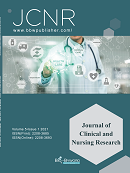Correlation Analysis of Neuropathic Headache and Depression and Anxiety
Abstract
Objective: To explore the relationship between neuropathic headache, and depression and anxiety, as well as to adopt reasonable methods to reduce patients’ depression and anxiety. Methods: From June 2019 to May 2021, a total of 89 neuropathic headache patients were treated in our hospital, which is Yidu Central Hospital of Weifang and they were recorded as the observation group. During the same period, healthy individuals were randomly selected using a random number table method and 91 cases were randomly selected and recorded as the control group. Through the questionnaire survey and the use of SAS and SDS scores, the anxiety and depression of healthy people were evaluated, and the correlation between neurological headache, and anxiety and depression were analyzed. Results: In the control group, the number of people with mild, moderate, and severe anxiety were three, two, and zero, accounting for 3.30%, 2.20%, and 0.00%, respectively. The total anxiety was 5.50%, and the SAS score was 31.23 3.22; In the observation group, the number of people with mild, moderate, and severe anxiety were fourteen, eleven, and six, accounting for 15.73%, 12.36%, and 6.74%, respectively. The total anxiety was 34.83%, and the SAS score was 49.56 4.98, which was measured. The data shows that the control group is significantly lower than the observation group in terms of the number of people or the anxiety score, and both P<0.05 are statistically significant; the number of mild, moderate, and severe depression in the control group is four, two, and zero, respectively. They were 4.40%, 2.20%, 0.00%, the total depression was 6.60%, and the SAS score was 33.23 3.24; the number of people with mild, moderate, and severe depression in the observation group were sixteen, eleven, and five, respectively. 17.98%, 12.36%, 5.62%, total depression degree was 35.96%, SAS score was 46.56 4.68. The measurement data showed that the control group was significantly lower than the observation group in terms of the number of people or the depression score, and both were P<0.05, which was statistically significant. Conclusion: Patients with neuropathic pain are usually accompanied by anxiety and depression. Anxiety and depression are also important factors that affect patients with neuropathic pain. Psychotherapy intervention for patients is very necessary to relieve patients’ anxiety and depression. Thereby reducing the pain of the patient.
References
Liu XM, 2019, What are the Causes of Headaches?, Wenhui of Health Care, (10):272.
Chi ZL, Guo JH, 2019, Clinical Observation of Headache Symptoms in Neurology. Digest of World Latest Medical Information, 19(57): 109-110.
Feng SX, 2019, Research on the Etiology and Treatment of Neuropathic Headache. Digest of World Latest Medical Information, 19(53): 101+103.
Chen YM, 2019, The Promotion of Health Education in the Rehabilitation of Patients with Neuropathic Headache. Capital Food and Medicine, 26(11): 171.
Liu L, 2019, Clinical Observation and Analysis of Headache Symptoms in Neurology. Electronic Journal of Clinical Medicine Literature, 6(40): 40.


